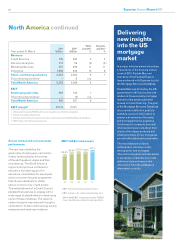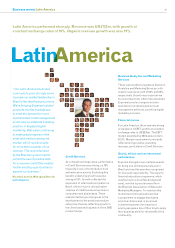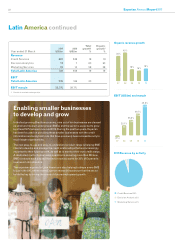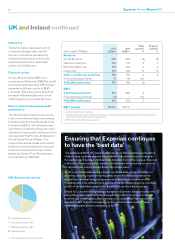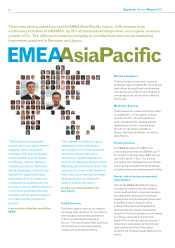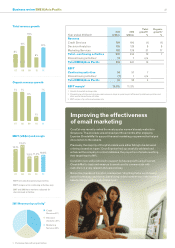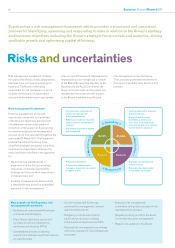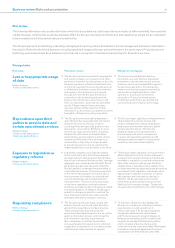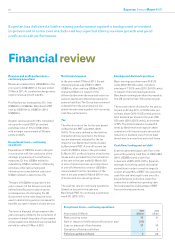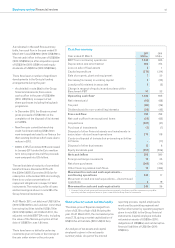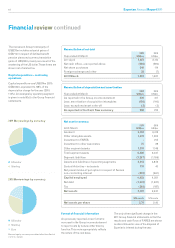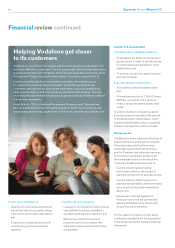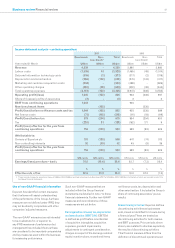Experian 2011 Annual Report Download - page 40
Download and view the complete annual report
Please find page 40 of the 2011 Experian annual report below. You can navigate through the pages in the report by either clicking on the pages listed below, or by using the keyword search tool below to find specific information within the annual report.
Experian Annual Report 2011
Risks and uncertainties
Experian has a risk management framework which provides a structured and consistent
process for identifying, assessing and responding to risks in relation to the Group’s strategy
and business objectives including the Group’s strategic focus on data and analytics, driving
profitable growth and optimising capital efficiency.
Risk management framework
Effective management of risk and
opportunity is essential to the delivery
of the Group’s objectives, achievement
of sustainable shareholder value and
protection of its reputation. Experian has
an established global risk management
process which has operated throughout the
year ended 31 March 2011. The framework
enables the risks of the Group to be
identified, analysed, evaluated, controlled,
monitored and reported. In doing so the
main functions of the Board are supported
by:
•identifying and managing risk in
alignment with the Group’s strategic
objectives, corporate responsibility
strategy and the long-term value drivers
in the business; and
•enabling management to demonstrate
a responsible and proactive, embedded
approach to risk management.
Key aspects of the Experian risk
management framework
•Defined and communicated business
principles and strategies
•Clear Group objectives, supported
by financial and non-financial key
performance indicators (KPIs)
•Standardised process to identify,
evaluate and manage significant risks on
an ongoing basis
•Control reviews and follow-ups
performed by management, internal
audit and third parties
•Budgetary controls and monthly
performance reviews, including
achievement of objectives and KPIs
•Regional risk management committees
with local oversight of risk management
processes
•Executive risk management
committee with global oversight of risk
management processes
•Regular reporting on risk to the Audit
Committee by senior management
•Regular risk updates to the Board
Risk management operates at all levels
throughout the Group, across geographies,
business lines, and operational support
functions. The Board is ultimately
responsible for risk management, which
includes the Group’s risk governance
structure and maintaining an appropriate
internal control framework. Management’s
responsibility is to manage risk on behalf
of the Board. By reporting regularly to the
Board and to the Audit Committee, the
Group's internal audit and the global risk
management functions provide support
to the Board in maintaining effective
risk management across the Group.
The corporate governance statement in
this report provides further detail on this
process.
R
e
p
o
r
t
i
n
g
M
o
n
i
t
o
r
i
n
g
R
e
p
o
r
t
i
n
g
M
o
n
i
t
o
r
i
n
g
• Full risk review undertaken at
least bi-annually by each
business and function
• Both nancial and non-nancial
risks recorded in controlled risk
registers
• Risk owners allocated to assess
and manage risk
• Controls analysed for adequacy
and effectiveness
• Risk analysed for impact,
probability and the speed
with which a risk impacts the
organisation (known as velocity)
to determine net exposure
• Risk owners identied
• Action plans implemented to
manage or respond to risk subject
to regular review
• Risk exposure reviewed and
risks prioritised
• Risk evaluation documented
in controlled risk register
AnalyseIdentify
Respond Evaluate
38




